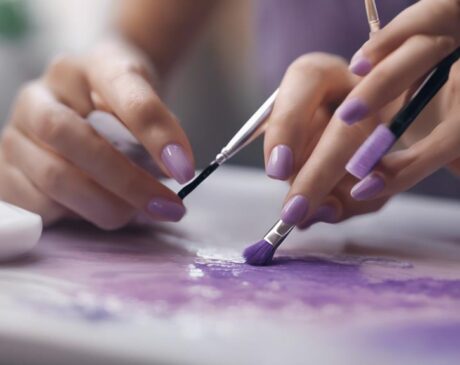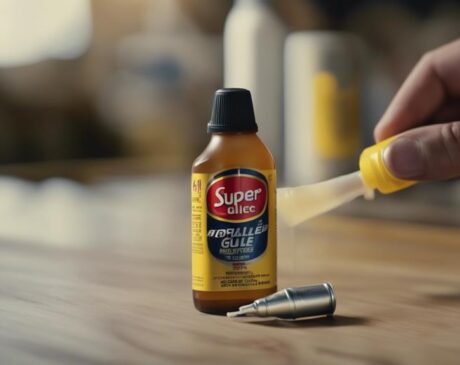What Is Nail Drill Used For?
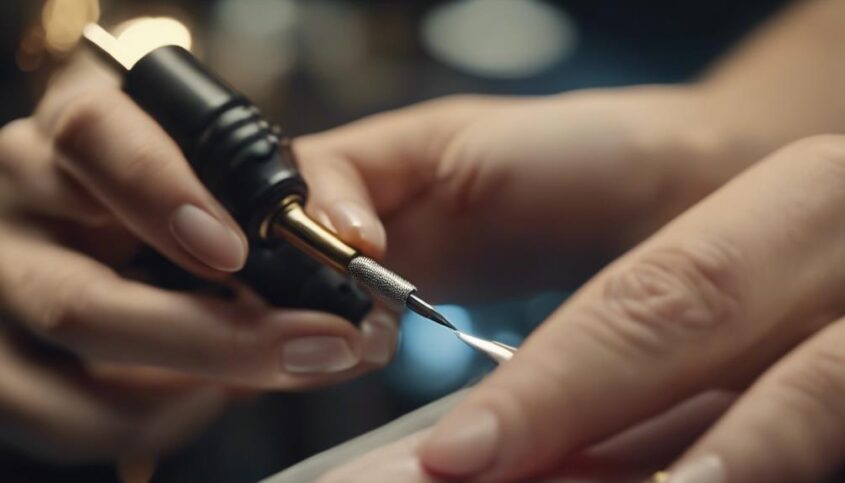
A nail drill is a versatile tool used in the beauty industry for shaping, filing, and smoothing nails with precision. It saves time, offers customizable speeds, and effectively removes old enhancements or rough edges. Nail drills are essential for intricate nail art designs and maintenance services. Understanding its components and functions enhances creativity in nail care practices. For professional results, safety measures are crucial. Higher expertise and precision are provided in salons, while at-home drilling poses risks without proper knowledge. Nail drill maintenance and care tips ensure smooth operation. Creative designs are achievable with nail drills. Explore further for detailed insights.
Key Takeaways
- Efficiently shapes, files, and smooths nails
- Removes gel polish, acrylic, or rough edges
- Enhances precision in nail art and maintenance
- Promotes overall nail health and integrity
- Saves time for technicians and clients
Benefits of Using a Nail Drill
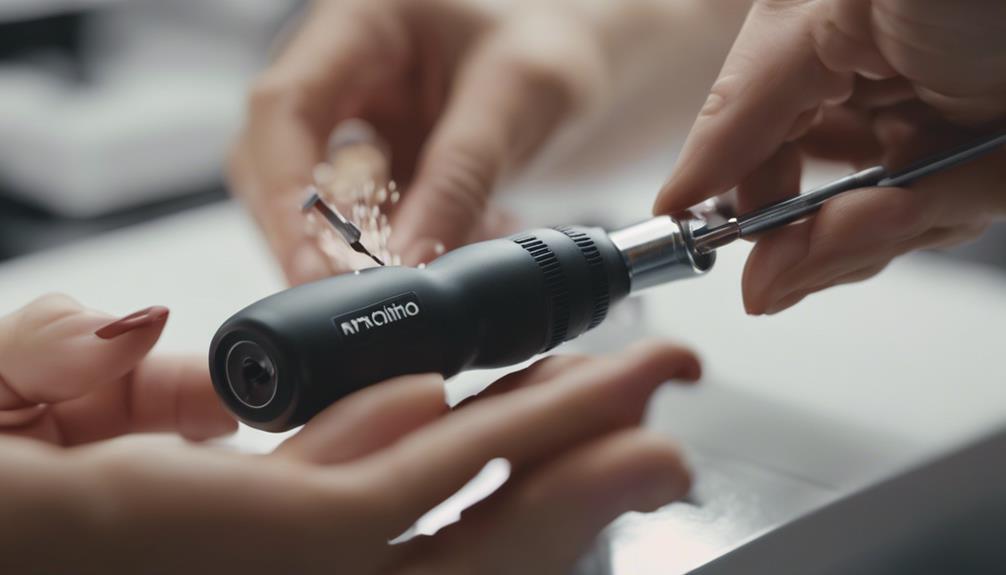
Utilizing a nail drill in professional nail care practices offers efficiency and precision in shaping, filing, and smoothing nails. Nail drills, equipped with various attachments such as drill bits and sanding bands, allow nail technicians to work quickly and accurately, saving time for both the technician and the client. The ability to adjust the speed and direction of the drill provides a level of customization that ensures a tailored nail care experience.
One significant benefit of using a nail drill is its ability to effectively remove old gel polish, acrylic enhancements, or rough edges without causing damage to the natural nail. This precision is crucial in maintaining the health and integrity of the nails, promoting overall nail health.
Furthermore, nail drills can aid in cuticle care, callus removal, and even intricate nail art designs. The versatility of a nail drill opens up a world of possibilities for creative and detailed nail services, catering to clients looking for unique and personalized nail treatments.
Types of Nail Services Utilizing Drills
Enhancing nail services through the use of nail drills expands the range of treatments available to clients seeking precise and detailed nail care. Nail drills are versatile tools that can be utilized in various types of nail services to provide efficient and professional results. One common service that benefits from nail drills is nail preparation. Before applying acrylic or gel extensions, nail drills can be used to shape and clean the natural nail, ensuring a smooth surface for optimal product adhesion.
Additionally, nail drills are essential in nail art services. Intricate designs such as 3D acrylic flowers or detailed patterns require precision and accuracy, which can be achieved more effectively with the use of a nail drill. Moreover, nail drills play a crucial role in nail maintenance services such as infills and rebalancing. They aid in the removal of old product, reshaping the nails, and maintaining the overall health and appearance of the nails. By incorporating nail drills into these services, nail technicians can elevate the quality of their work and provide clients with innovative and flawless nail treatments.
Nail Drill Components and Functions
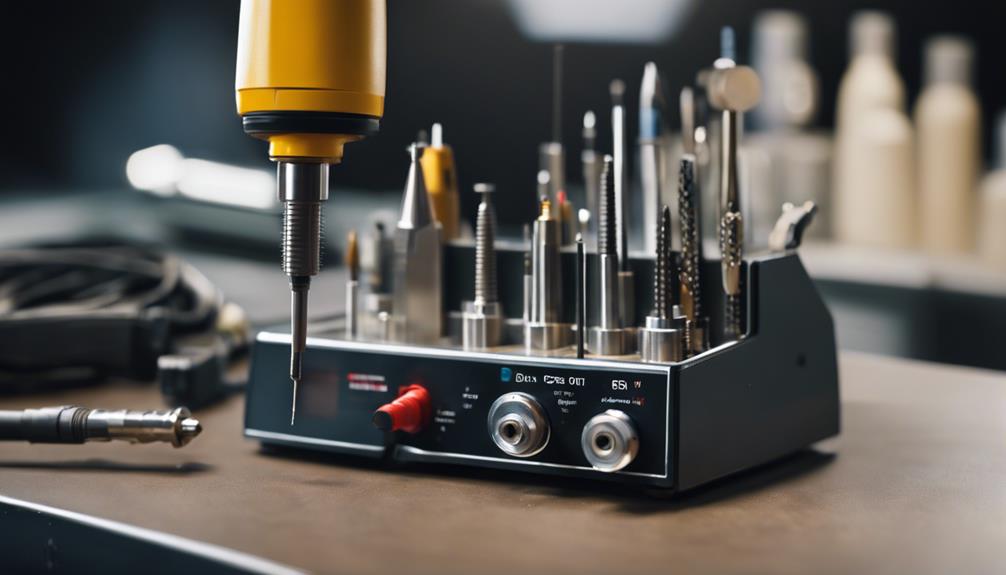
The components of a nail drill play a crucial role in its functionality. Understanding the parts, their functions, and how to utilize them effectively is essential for a successful nail drilling experience. This guide will provide an overview of the drill's components, their functions, and offer insights into their practical uses.
Drill Parts Overview
Examining the various components and functions of a nail drill provides a comprehensive understanding of its operational mechanisms. The main parts of a nail drill include the handpiece, power source, control unit, and drill bits. The handpiece, often ergonomic in design, houses the motor responsible for rotating the drill bits. The power source can be electric or battery-operated, providing the necessary energy for the drill to function. The control unit allows for speed adjustments, forward/reverse rotation, and sometimes foot pedal operation. Drill bits, available in various shapes and sizes, are essential for different nail procedures such as filing, shaping, and buffing. Understanding how these components work together enhances the efficiency and precision of nail drill use.
Functions of Nail Drill
Understanding the specific functions of each component of a nail drill is crucial for achieving optimal performance and precision in nail procedures. The following components play essential roles in the functionality of a nail drill:
- Handpiece: Responsible for holding the drill bits and transferring power to them.
- Drill Bits: Come in various shapes and sizes for different nail treatments.
- Speed Control: Allows for adjusting the rotation speed of the drill bits for different tasks.
- Forward/Reverse Switch: Enables changing the direction of the drill bit rotation, aiding in versatility during nail procedures.
Mastering the functions of these components will enhance efficiency and creativity in nail care practices.
Component Uses Guide
Utilizing a nail drill effectively requires a comprehensive understanding of the specific applications of its various components. The handpiece, or drill body, houses the motor responsible for powering the drill bits. Different drill bits serve distinct purposes: carbide bits are ideal for shaping and refining acrylic nails, while diamond bits work well for cuticle cleaning and callus removal. Mandrels and sanding bands aid in smoothing and buffing the nail surface. Foot pedals control the drill's speed, offering precision during intricate nail procedures. Understanding how each component functions ensures a seamless nail drilling experience, allowing professionals to deliver precise and efficient nail services. Mastery of these components enhances creativity and innovation in nail artistry.
Safety Measures When Using a Nail Drill
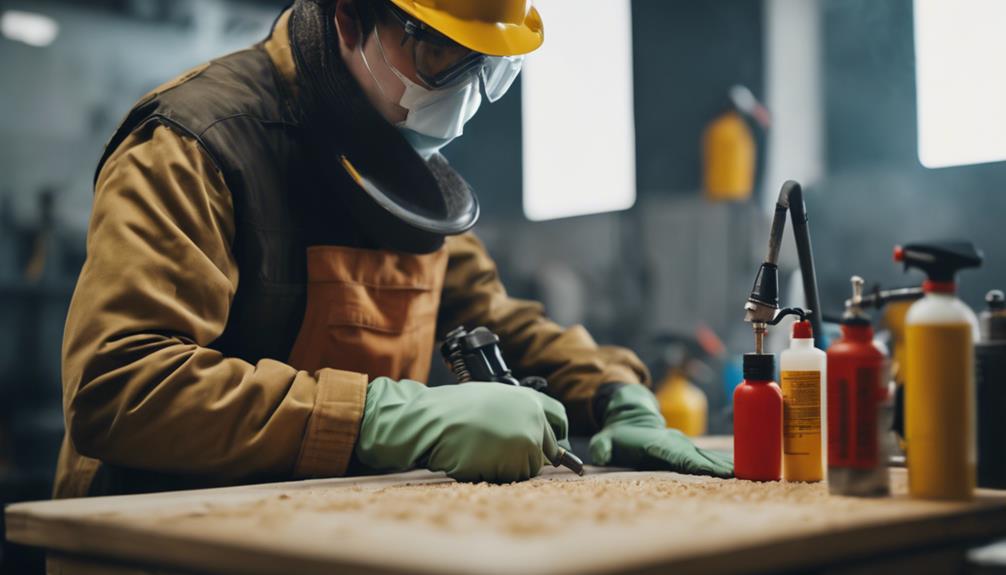
When operating a nail drill, it is essential to prioritize safety measures. This includes wearing proper protective gear such as safety glasses and a dust mask, choosing the correct drill bit for the intended purpose, and applying gentle pressure to prevent injury or damage to the nails. Ensuring these precautions are taken can help maintain a safe and effective nail drilling experience.
Proper Protective Gear
To ensure safe operation when using a nail drill, it is essential to wear proper protective gear. Nail drills can cause potential hazards if not handled correctly, making safety measures crucial. The following protective gear is recommended when using a nail drill:
- Safety goggles to protect your eyes from debris.
- Dust mask to prevent inhalation of harmful particles.
- Nitrile gloves for hand protection and a better grip on the drill.
- Apron or protective clothing to shield your skin from any accidental contact with the drill.
Correct Drill Bit
Selecting the appropriate drill bit is essential for ensuring safe and effective operation when using a nail drill. The correct drill bit can make a significant difference in the outcome of your nail care routine. Opt for high-quality drill bits made from durable materials that are designed specifically for use on nails. Consider the size and shape of the bit based on the task at hand, whether it's removing gel polish, shaping acrylics, or refining cuticles. Using the right drill bit not only enhances precision but also minimizes the risk of accidents or damage to the nails. Invest in a variety of drill bits to cater to different nail care needs and always prioritize quality and compatibility for optimal results.
Gentle Pressure Application
Ensuring gentle pressure application while using a nail drill is crucial for maintaining precision and protecting the nails from potential harm. When utilizing a nail drill, consider the following safety measures:
- Adjust Speed Settings: Start at a lower speed and gradually increase as needed to prevent excessive pressure.
- Use a Light Touch: Let the drill do the work; avoid pressing down too hard to reduce the risk of nail damage.
- Maintain Consistent Motion: Move the drill smoothly and steadily across the nail surface to avoid uneven results.
- Take Breaks: Give your nails intermittent breaks during the drilling process to prevent overheating and maintain nail health.
Professional Vs. At-Home Nail Drilling
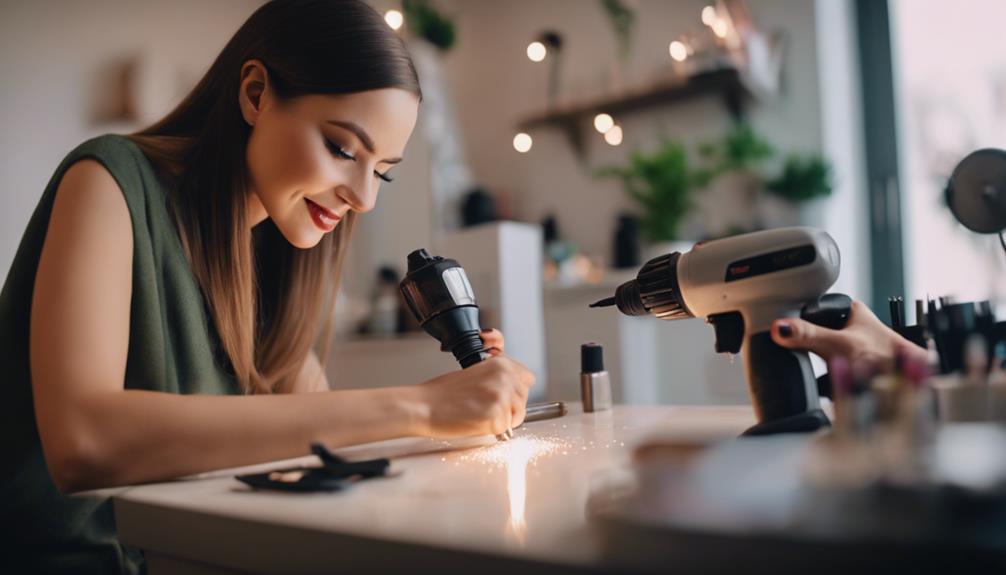
When considering nail drilling, the distinction between professional services and at-home practices is crucial for achieving safe and satisfactory results. Professional nail drilling services, often offered in salons or by trained technicians, provide a higher level of expertise and precision. These professionals are skilled in using nail drills to shape, refine, and remove acrylic or gel enhancements with finesse and accuracy. They understand the nuances of nail structure and how to avoid causing damage or pain to the client.
On the other hand, at-home nail drilling, while convenient, can pose risks if not done properly. Individuals should educate themselves on the correct techniques and safety measures before attempting to use a nail drill at home. Without proper knowledge and practice, there is a higher likelihood of over-filing, damaging the natural nail, or causing injury.
Nail Drill Maintenance and Care Tips
To maintain the effectiveness and longevity of your nail drill, proper care and maintenance practices are essential. Here are some tips to ensure your nail drill stays in top condition:
- Regular Cleaning: After each use, make sure to clean the drill thoroughly to remove any nail dust, debris, or residue. Use a small brush to clean the drill bits and a soft, damp cloth for the body of the drill.
- Proper Storage: Store your nail drill in a clean and dry place to prevent dust buildup and potential damage. Consider investing in a case or storage container to keep all components organized and protected.
- Routine Maintenance: Check the drill regularly for any signs of wear and tear, such as frayed cords or loose components. Replace any damaged parts promptly to avoid further issues.
- Lubrication: Apply a small amount of lubricant to the moving parts of the nail drill to ensure smooth operation and prevent overheating. Follow the manufacturer's guidelines for the type of lubricant to use.
Creative Nail Designs With Nail Drills
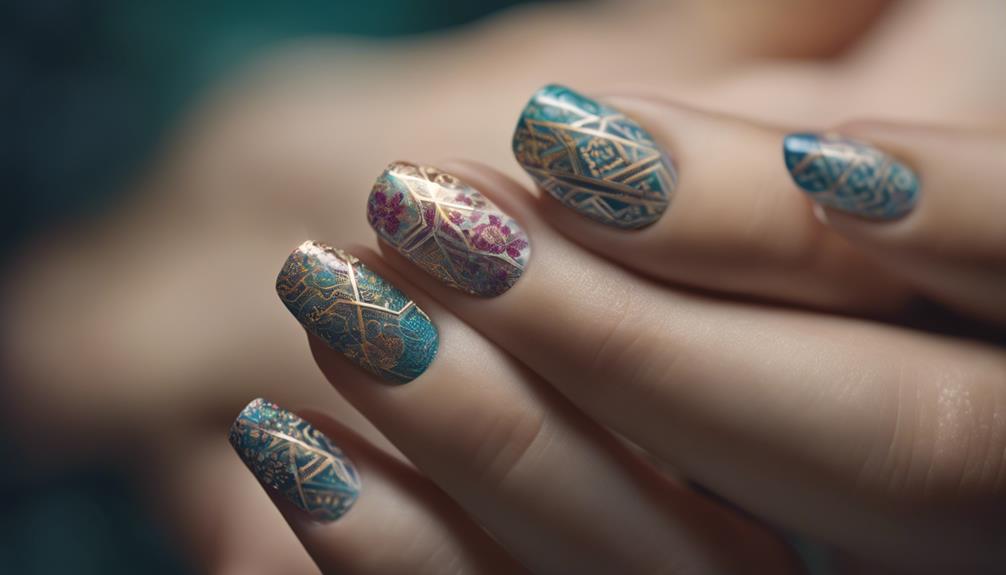
Exploring creative nail designs through the use of a nail drill allows for intricate and precise detailing in manicures. Nail drills open up a world of possibilities for nail artists to unleash their creativity and craft unique designs that captivate attention. With the ability to shape, carve, and etch intricate patterns, nail drills enable artists to achieve stunning effects that are otherwise challenging to accomplish by hand alone.
One popular creative design technique involves using a nail drill to create delicate floral patterns. By carefully etching petals and leaves into the nail surface, artists can achieve a beautifully detailed floral look that adds elegance to any manicure. Additionally, nail drills can be used to create mesmerizing geometric designs, intricate lace patterns, or striking abstract artwork, giving nails a modern and artistic flair.
Whether you prefer minimalist designs or bold statement looks, incorporating a nail drill into your nail art arsenal opens up a world of possibilities for expressing your unique style. Embrace the versatility and precision of nail drills to elevate your manicures to new artistic heights.
Frequently Asked Questions
Can Nail Drills Be Used on Natural Nails or Are They Only for Artificial Nails?
Nail drills can be used on natural nails, not just artificial ones. They offer precise shaping and buffing, creating a polished look. Professionals recommend using them with care to avoid damage. Embrace the versatility!
How Often Should Nail Drill Bits Be Replaced?
Regularly replacing nail drill bits is essential for maintaining optimal performance and ensuring a safe and hygienic nail care practice. Industry standards recommend replacing bits every three to six months, or sooner if signs of wear or dullness are observed.
Are There Any Health Risks Associated With Using a Nail Drill?
While the art of manicures evolves, the use of nail drills comes with potential health risks if not used properly. Hyperbolically, these risks can be likened to navigating a delicate balance between achieving stunning nails and avoiding harm.
Can a Nail Drill Be Used to Remove Gel Polish or Acrylic Nails?
A nail drill, a versatile tool in nail care, is commonly used to remove gel polish or acrylic nails efficiently. Its precision and power make it a popular choice among professionals and individuals seeking salon-quality results at home.
Are There Any Specific Techniques or Tips for Using a Nail Drill on Different Nail Shapes or Lengths?
When using a nail drill on different nail shapes or lengths, it is essential to adjust the speed and pressure accordingly. For rounded nails, use a lower speed, while square nails require precision and slower movements.

